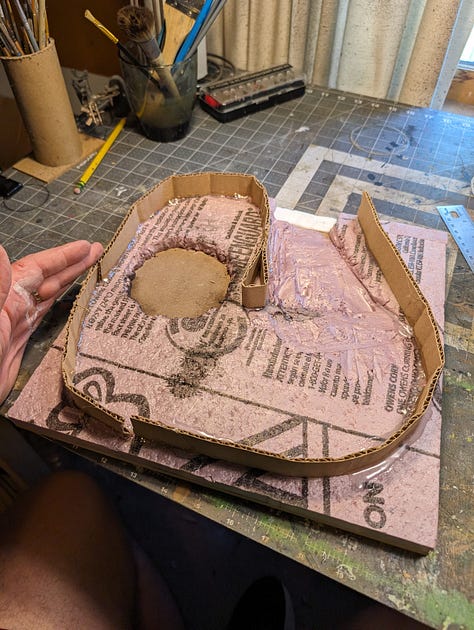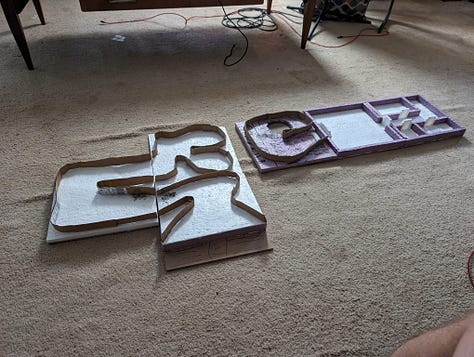Greetings dungeon masters!
This will be a shorter email today. I’m currently buried under work for Green Dragon Fest, getting all the merch and everything sorted, as well as crafting my dungeons for the game:



I’m also busy coming up with a system to quickly knock out an old school ~9 room dungeon, so look forward to that soon!
Speaking of dungeon design…
How To Design Dungeons Like A Metroidvania
Metroidvania games are fantastic examples of massive dungeon design. There’s a lot we can learn from them as dungeon masters.
They show us how to recontextualize dungeons as players explore them, how to define narratives for each section of a megadungeon, and how to reward players for exploring the dungeon with further information about the dungeon itself.
Let’s deconstruct this.
RECONTEXTUALIZING EXPLORATION
When you first jump into a metroidvania, you’re limited by what you can explore. Physical and environmental obstacles, high level enemies and inaccessible areas will block your path.
But eventually, you’ll find the right upgrade, knowledge or gain enough experience to unlock new areas of the map. And suddenly, all those places you’ve been before become fresh and exciting.
We as dungeon masters can accomplish this in a number of ways. Probably the easiest is to have some central looping point that players will regularly revisit over and over again through the course of the dungeon’s exploration.
Of course, since your players will have access to magic and equipment, they’re not going to be completely cut off from every path, but there’s a lot you can do to steer them in the direction you want.
In this central hub, use the branching pathways to telegraph the types of environmental hazards, monsters and factions they might encounter. The litter around an extinguished campfire, the strange scent of a dung pile, or leftover tools used to topple a statue can go a long way in informing what kinds of problems the party is about to be up against, or stop them from heading that way until they have the right tools.
With that said, you can’t just have the players return to this central hub to lazily pass through it. Their understanding of this location needs to change every time they do so as well. Did the players notice the statue in the worship hall had two deep sockets for eyes?
When they come back through, perhaps they overhear a pair of ogres lamenting how they have lost the “eye stones.” Now the players know that those stones are somewhere in the dungeon. And more, for some reason those stones are important. Slowly add to the story of the dungeon as the players use this hub by reinforcing the dungeon’s narrative.
THEMED LOCATIONS
In every metroidvania game, there are a number of distinct locations that can be explored, each with their own theme. The theme informs the kinds of puzzles you’ll encounter, the kind of enemies you’ll battle, and even the information you acquire.
Similarly, we can do the same thing to make each section of our dungeon more memorable and distinct from every other part of it. Think about what makes each section unique. Is it a mushroom covered cave system, or a flooded aquifer?
Once you have your theme set, you can really drive it home by modifying the key entrances to these locations so they are highly foretelling. Players will remember a highly descriptive location, especially if it’s clear that this is a transition point to a new area. They are going to want to figure out a way in.
Players will develop a sense of wonder if they encounter a door covered in runes and bloody hand prints, as opposed to an otherwise mundane door in the same area. Perhaps there is a cult of vampire worshipers that live beyond, and the threshold was painted this way as a warning to other denizens who live in the dungeon.
KNOWLEDGE AS THE REWARD
One of the best things we can do as dungeon masters is to think about the kind of information that would be relevant to one part of the dungeon, and then somehow connect that information to an entirely different part of it. This is really where the previous two concepts tie together.
A dead goblin in one part of the dungeon might have a scrawled note in his pocket, detailing problems he encountered in an underground Mushroom Forest, clearly a different part of the dungeon. If they haven’t been there, they can use the knowledge gained from a note to avoid those issues.
Additionally, having these odd or strange tidbits of knowledge scattered around the dungeon allows your players to lean into divination spells like Detect Magic, Identify, Locate Object, or even Legend Lore.
Then, the players get to feel super smart for putting together the parts of a larger puzzle and it helps make each distinct part of the dungeon feel somehow interconnected. Better still, we as dungeon masters will know what kind of information to provide for divination magic, or exceptionally high intelligence checks.
So, the next time you design a large dungeon, try doing this yourself!
Be ready to recontextualize a central looping area to keep it interesting. Break the dungeon up into subsections with their own substory and theme, and use tidbits of information found in one section of the dungeon to interconnect it to other parts. You’ll be impressed at how rich and alive your dungeon will feel.
Feeling Adventurous? Go On These Side Quests
All the latest news, deals, jobs, tips and more in the TTRPG world.
How Roll For Combat Makes More RPG Content Than WotC in Half the Time: I interview Stephen Glicker, founder of the largest Pathfinder publisher, on his business and content strategy.
Hiring - Organized Play Coordinator: If you have any event management experience, check out this US remote job for UVS Games.
D&D Dungeon, The False Tomb: Made by my friend Justin Alexander, here’s a fun little dungeon you can include in your campaigns.
Dungeon Geomorphs: Skeleton Code Machine has a great post on ways to use modular tiles to create your maps and dungeons.
Get The Pathfinder Mega Bundle and Fallout RPG Bundle On Sale: HumbleBumble has some more great pay what you want sales ending soon.
Free One Page Dungeon: Moira Games is offering their 2023 One Page Dungeon Contest winner, They Dug Too Deep, for free along with some extra goodies.
Want to get your Kickstarter, game or TTRPG related product in front of thousands of eager players? Click here for sponsorship options!
That’s all for this week! If you'd like to stay up to date about the various behind the scenes content for Dungeon Masterpiece, TTRPG news, and what else I'm working on, please subscribe to this newsletter:

